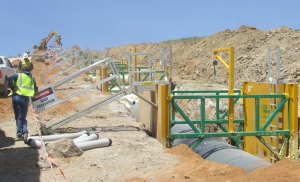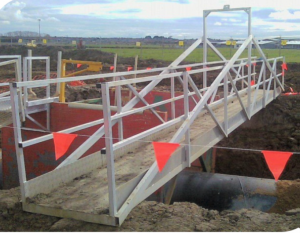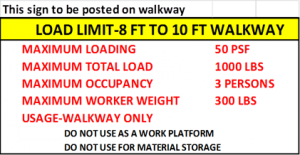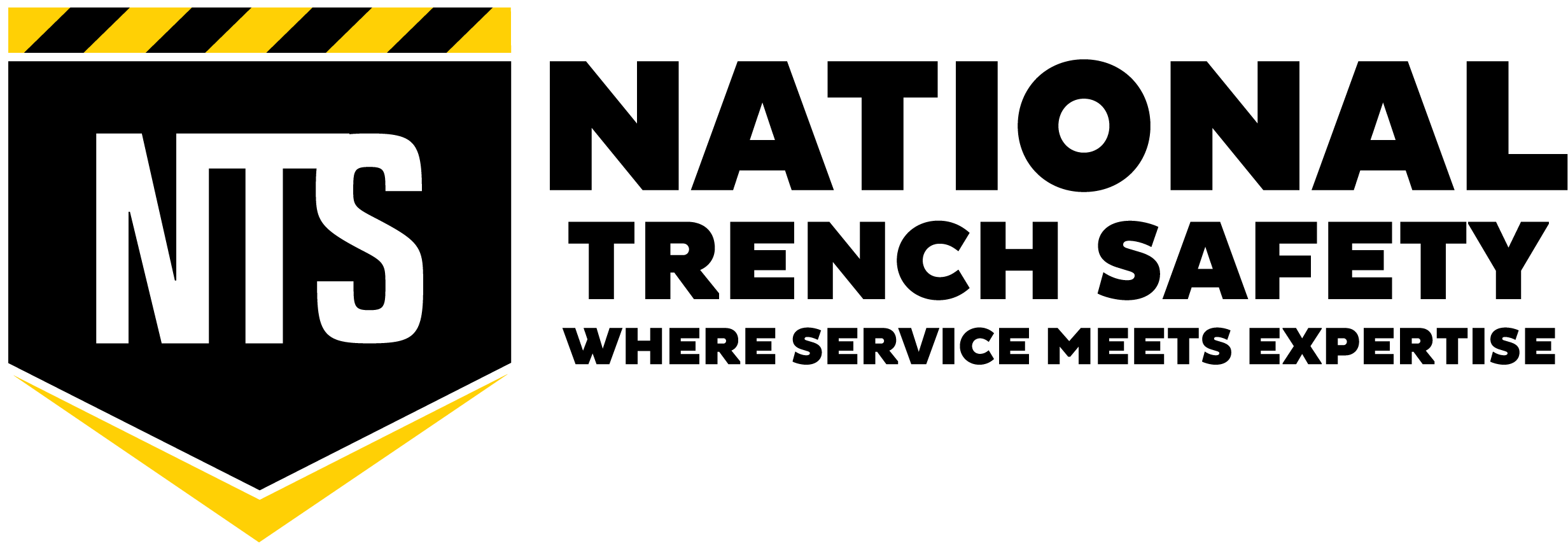 Excavation work presents several situations where temporary access bridges can be necessary. One common example is a pipeline excavation utilizing shoring shields combined with sloping, which will require a bridge to provide worker access from the unsloped surface to the shoring shield. OSHA Subpart P, 1926.651(l) provides some guidance in this respect:
Excavation work presents several situations where temporary access bridges can be necessary. One common example is a pipeline excavation utilizing shoring shields combined with sloping, which will require a bridge to provide worker access from the unsloped surface to the shoring shield. OSHA Subpart P, 1926.651(l) provides some guidance in this respect:
“Walkways shall be provided where employees or equipment are required or permitted to cross over excavations. Guardrails which comply with 1926.502(b) shall be provided where walkways are 6 feet (1.8 m) or more above lower levels.”
Structures such as sewer manholes, pump stations, and other buried structures that are constructed inside sloped excavations, may require bridges at the top in order to allow workers to access and finish work inside them prior to backfill. Although there are many construction disciplines (building construction, masonry construction, plasterers, etc.) where bridges are used, this article focuses the discussion on the structural and safety requirements of worker-access bridges associated with excavation work.
As I reviewed the OSHA standard for this article I found that trench bridges may be best described as a scaffold in Safety and Health Regulations for Construction, Subpart L, Scaffolds, S1926.450(b)Definitions.
Scaffold means any temporary elevated platform (supported or suspended) and its supporting structure (including points of anchorage), used for supporting employees or materials or both.
Where Subpart P requires structural walkways, ramps, or bridges the Competent Person must look at Subpart L to determine the structural and safety requirements to construct them. Here are some requirements pertinent to temporary bridges found In Subpart L, Scaffolds:
- 1926.451(a)(1)- …, each scaffold and scaffold component shall be capable of supporting, without failure, its own weight and at least 4 times the maximum intended load applied or transmitted to it.
- 1926.451(d)(3)(i)- Before the scaffold (bridge) is used, direct connections shall be evaluated by a competent person who shall confirm, based on the evaluation, that the supporting surfaces are capable of supporting the loads to be imposed.
- 1926.454(a) The employer shall have each employee who performs work while on a scaffold (bridge) trained by a person qualified in the subject matter to recognize the hazards associated with the type of scaffold being used and to understand the procedures to control or minimize those hazards. The training shall include the following areas, as applicable:
- 1926.454(a)(4) The maximum intended load and the load-carrying capacities of the scaffolds used
- 1926.454(b) The employer shall have each employee who is involved in erecting, disassembling, moving, operating, repairing, maintaining, or inspecting a scaffold trained by a competent person to recognize any hazards associated with the work in question. The training shall include the following topics, as applicable:
- 1926.454(b)(1) The nature of scaffold hazards;
- 1926.454(b)(2) The correct procedures for erecting, disassembling, moving, operating, repairing, inspecting, and maintaining the type of scaffold in question;
- 1926.454(b)(3) The design criteria, maximum intended load-carrying capacity, and intended use of the scaffold;
- 1926.454(b)(4) Any other pertinent requirements of this subpart.
These are just a few of the key requirements and by no means is meant to be an exhaustive list of the pertinent standards. Before a temporary bridge is put in place, all Subpart L, Scaffolds should be reviewed by the employer and its Competent Person to ensure a thorough understanding of what’s required. The standard establishes  requirements for structural capacity, Competent Person training, and safety training for workers using the scaffold (bridge).
requirements for structural capacity, Competent Person training, and safety training for workers using the scaffold (bridge).
Similar to the early trench safety industry prior to the mass production of manufactured shoring equipment, construction bridges were historically built with lumber and timber at the job site. And similar to the trench safety industry today, contractors now have a variety of manufactured bridges and handrails available. Thus the task for the Competent Person is to understand the requirements and specifications of his/her project, how to safely install the bridge, how to inspect the bridge, and how to remove the bridge in addition to the general knowledge required of the OSHA standard.
As it relates to Subpart P, Excavations, the following could be a typical specification that a Competent Person may request from a supplier when renting or purchasing a typical worker access bridge:
Dimensional Requirements
- Length: as necessary plus 4 ft for a landing pad
- Width: 3-ft 6-in
- Hand Rail Height: between 39-in and 45-in from the top of the deck
- Mid Rail: center at 20-in to 22-in from the top of the deck
- Toe Kick: from the deck top to minimum 3.5-in above
- Decking: slip-resistant and completely drained
Structural Requirements (mainly for workers and hand tool access)
- Bridge Allowable Loading: distributed load minimum of 50 pounds per square foot (PSF)
- Point Loading: One (1) 300-pound person including tools per 2-ft of bridge length
- Handrail Strength: 200-pound point load directed in a vertical direction and horizontal direction not simultaneously, applied at any point between support posts
- Middle Rail: 150-pound point load directed in a vertical direction and horizontal direction not simultaneously, applied at any point between support posts
- Toe Kick: 50-pound point load directed in a horizontal direction, applied at any point between support posts
- Lifting: the bridge weight should be posted and the bridge should have clearly marked lifting attachments, d-rings, and or shackle connection points
Posted Manufacturer Specification Signage (should provide the following)
- Intended Load: personnel and small tool access only

- Restricted Access:
- Material or equipment storage
- Access and egress only
- No working from the bridge deck
- Allowable Load Capacity: 50 PSF
- Allowable Worker Capacity: number of workers (1 Worker is a maximum combined worker weight + hand tools weighing 300 pounds or less)
- Bridge Weight: number of pounds (or another unit of measure) for the purpose of rigging, lifting, and other operations requiring the weight of the bridge
- Usage Notes:
- The bridge shall be set stable at both ends
- The bridge shall be inspected by a Competent Person for the stability of end bearing conditions, loose pins, bolts, and nuts, and damage to the structure
- A bridge may not be rolled or moved with workers on it
- Workers involved in erecting, disassembling, moving, operating, repairing, maintaining, and or inspecting this bridge shall be trained in accordance with OSHA Requirements by a Competent Person to recognize any hazards associated with the work
- The bridge shall be set from the ground uphill or downhill to the landing location at a slope no greater than 6 ft horizontal to 1 ft vertical
Before the bridge is delivered to the site the Competent Person must ensure that the bridge setting operation is adequately planned. If the bridge is to be set with an excavator, or crane, proper size equipment and rigging should be planned. The structure attachment end may require a worker on a ladder or fall protection in order to fasten the connection properly.
After the bridge is delivered to the site the Competent Person must ensure the bridge is set stable at both ends, landside to shoring side or landside to landside. A 20-ft long bridge fully loaded should have the landside end set back from the edge of the trench at least 2 ft and the shoring side should have an attachment so that it cannot slide sideways or shift when workers are mounting a ladder and or stairway. The load limit and intended usage sign should be clearly posted. The bridge should be inspected at the start of every shift. Any dings, dents, permanent deflection, and or other damage in the main beams or other structural elements should be an immediate cause for decommissioning the bridge. The landside abutment should not be moving or settling and the structure side attachment should be tight.
For contractors that choose to build their own bridges and walkways at the site utilizing wood, there is an excellent publication that was developed by OSHA. The publication is a 73-page, free guide (A Guide to Scaffold Use in the Construction Industry) that can be downloaded from the OSHA website.
National Trench Safety has a complete line of walkways, bridges, and accessories including wheel kits and ladder access units. Walkways are available from 4-ft to 10-ft and bridges are available from 10-ft to 20-ft with custom-designed units also available. The standard operation for these walkways and bridges is designed for personnel and small tool access only.
DISCLAIMER: the information contained in this article is provided for general and illustrative purposes only and is not to be considered Site Specific and or designated engineering for any project or work zone, nor is it to be used or considered to be tabulated data, technical data, advice and or counsel to be used on any job site. Each project is different and is the responsibility of the employer’s designated Competent Person to make decisions on what systems and methods may be used in compliance with federal and local regulations, manufacturers tabulated data, engineered drawings, and other plans.





